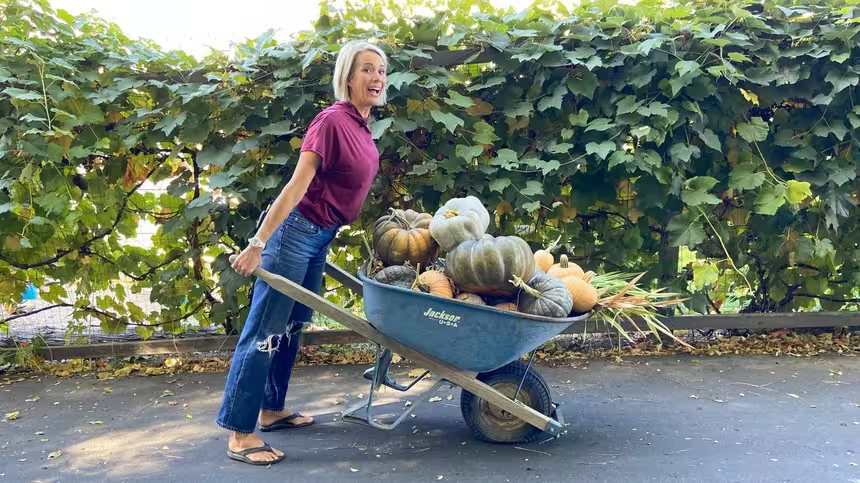Modern Gardener
Foraging Weeds in Your Backyard
Episode 79 | 6m 8sVideo has Closed Captions
See how to forage for dandelions, common mallow, and purslane in your backyard.
Weeds may seem like a nuisance, but some of those unwanted plants may be worth a second look! Urban forager and chef Megan Mullineaux shares some delicious ways to add dandelions, common mallow, and purslane to your next meal.
Problems playing video? | Closed Captioning Feedback
Problems playing video? | Closed Captioning Feedback
Modern Gardener is a local public television program presented by PBS Utah
Funding for Modern Gardener is made possible in part by Merit Medical and Red Butte Garden & Arboretum.
Modern Gardener
Foraging Weeds in Your Backyard
Episode 79 | 6m 8sVideo has Closed Captions
Weeds may seem like a nuisance, but some of those unwanted plants may be worth a second look! Urban forager and chef Megan Mullineaux shares some delicious ways to add dandelions, common mallow, and purslane to your next meal.
Problems playing video? | Closed Captioning Feedback
How to Watch Modern Gardener
Modern Gardener is available to stream on pbs.org and the free PBS App, available on iPhone, Apple TV, Android TV, Android smartphones, Amazon Fire TV, Amazon Fire Tablet, Roku, Samsung Smart TV, and Vizio.

Modern Gardener
Subscribe to the Modern Gardener YouTube channel for more videos and information on gardening, and share your gardening tips and stories in the comments section. Can't wait to GROW with you!Providing Support for PBS.org
Learn Moreabout PBS online sponsorship(lighthearted music) - Personally, I think dandelions are so beautiful.
Did you know that some weeds are actually edible and packed with nutrients and flavor?
- Yeah, and honestly, by the end of the summer, I know that this yard is going to just be barren except for these gorgeous green weeds.
- We're here in the backyard of homeowner Megan Mullineaux.
She's a chef, grad student, and urban forager, and she's going to talk with us about three common weeds you can eat and cook with.
(lighthearted music) Megan, thank you so much for being here today with us to talk about this wildly unique and uncommon hobby of yours.
Tell us, what is a weed?
That's a loaded question.
- It is a loaded question.
So a weed is really just a plant out of place.
Just for example, if I had planted tomatoes and then the seeds dispersed somehow, and I had a tomato plant that popped up in the middle of my lawn, it would be unwelcome there.
It wouldn't be something that I would want.
I'd be concerned that my dogs might trash it or something.
So in that instance, that would be a weed.
- Gotcha.
- Whereas there are people who cultivate things like the dandelion in order to sell it.
So in that circumstance, it's not a weed, even though popping up in my lawn around here, it's considered a weed because it's a plant out of place.
- Okay, gotcha.
(soft, upbeat music) - People are so used to me, like, "Can I come and weed your yard?"
- Yeah, right?
- It's great.
(music continues) - Okay, so we have some things here that we foraged from your yard.
Very common.
Can you tell us about 'em?
- Yeah, I'd love to.
So these are just dandelion leaves.
People pay for these in the store.
It's a powerhouse of nutrition, more nutritious than kale or spinach.
But it gets better, and actually, the flower of the dandelion's actually sweet.
You can try that.
- Yeah, that's what I did.
I used to pull out all the petals.
It's a lot of work, but.
- Work, but worth it.
(birds chirping) Here's the dandelion leaves and the root.
And you can actually cook this entire thing, just roasted.
Obviously, wash the dirt off, and then give it a little bit of oil, salt and pepper, and roast it in your oven, and it's amazing.
It's really delicious.
(soft, upbeat music) So this is called the common mallow plant.
- I see that everywhere.
- Yeah, everywhere.
- I didn't even know what it was called.
Common mallow.
- Common mallow.
Every part of this plant is edible.
When you process this plant by either cooking or crushing, it will create a gelatin-like substance.
(birds chirping) Of interest to me are these...
They call them cheese wheels, but it's actually these little pods that are the base of the flower.
- [Ashley] Okay.
- You can do so much with these.
So I actually like to take these and toast them, and then I can put 'em in salads, and they're so delicious.
- [Ashley] Oh, wow.
- [Megan] Now, if you tear off the green section on the outside, you'll note that it's actually sweet.
- [Ashley] It's just like a little button.
- It is, and you can see why they call it a cheese wheel, 'cause it has these little sections.
It's segmented.
(Ashley hums in approval) But it has kind of a sweet, marshmallowy flavor.
- Totally.
(soft, upbeat music) - So at the bottom of our basket, last but definitely not least, we have purslane.
This is one of my favorite plants to cook with.
Purslane, actually, or purse-lane...
It can be pronounced either way.
The entire plan is edible.
- I've seen this being sold at farmer's markets, and it gets really big, and the leaves get really big.
- Yes, it gets huge.
It's a succulent, as you can see.
So it's really hardy.
(birds chirping) - [Ashley] Can we taste it?
- Of course.
- Mmm.
- Right?
It's a really bright lemon pepper flavor.
- Yeah.
Ooh, I like that.
This is my first time tasting... Mmm.
- And it doesn't have any of that bitter flavor.
You can use the leaves raw.
You can cook down the entire plant and use it to flavor things like, as I mentioned, pasta is wonderful.
I make a really good gnocchi with this.
- Nice.
(soft, upbeat music) Well, we wanted to do this video with you because you've done this, but we don't wanna just tell any of our viewers, like, "Go out and start eating weeds."
So can you just talk a little bit about some of the precautions to take, safety?
- Yeah, absolutely.
Just a good rule of thumb, if you're not sure what it is, don't eat it.
As you mentioned, I've been doing this a long time, so I know what the lookalikes are, and I know how to avoid them.
But you don't start out knowing that.
You start out just first identifying the plant, and then as you go along, you learn, "Oh, this has a slightly different stem."
If you're unfamiliar with the water source, don't eat it.
So I became really comfortable calling parks departments and asking about their water sources.
Like, "What kind of water are you using to water in here?"
Know if there's pesticides or herbicides that have been used on or around the plants and if that's affecting the water source as well.
And then also, if you're not sure what it is, just don't eat it.
So this just feels like a gift to me.
This is just a little gift.
I didn't do anything to earn it.
I just go out and take it up and use it.
And it's just so wonderful.
And so it really helps me to have a unique relationship with whatever environment I'm in.
- Yeah.
We hope you enjoyed this video and learned some interesting things about these common edible weeds.
But remember, always take precaution.
Do your research before eating anything.
And if you like this video, subscribe to Modern Gardener and give us a thumbs up.
(soft music)


- Home and How To

Hit the road in a classic car for a tour through Great Britain with two antiques experts.












Support for PBS provided by:
Modern Gardener is a local public television program presented by PBS Utah
Funding for Modern Gardener is made possible in part by Merit Medical and Red Butte Garden & Arboretum.
